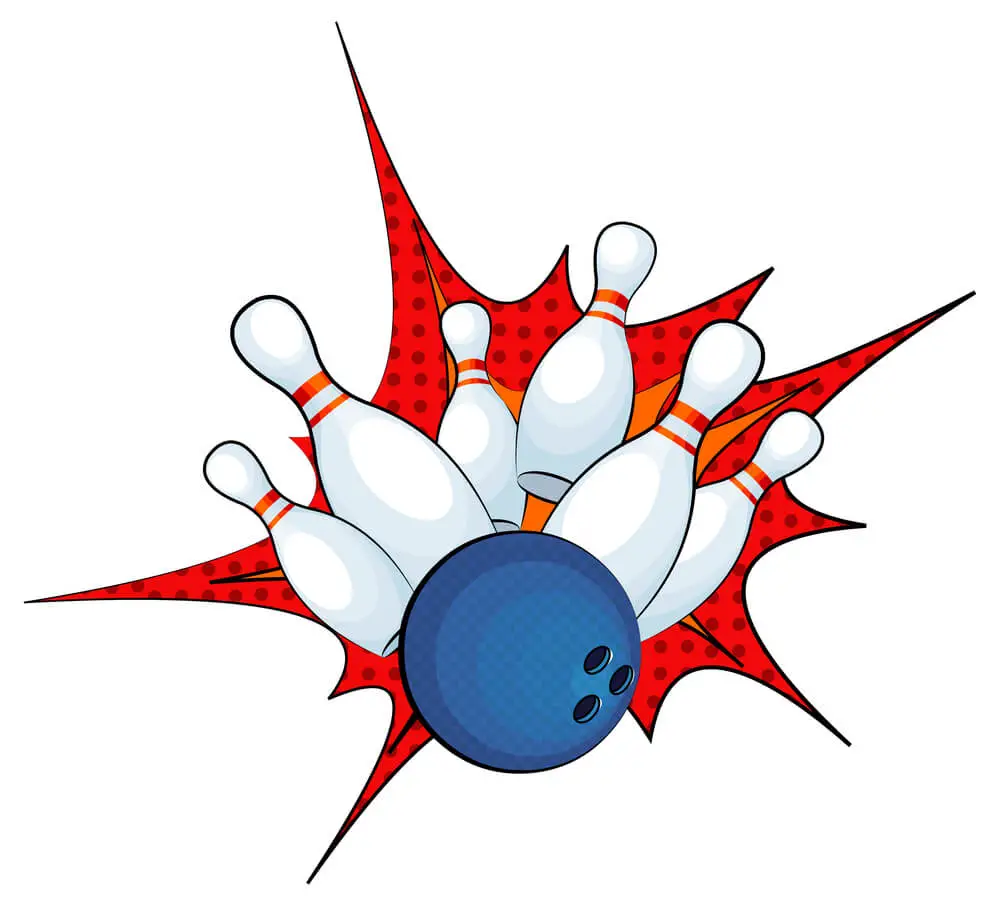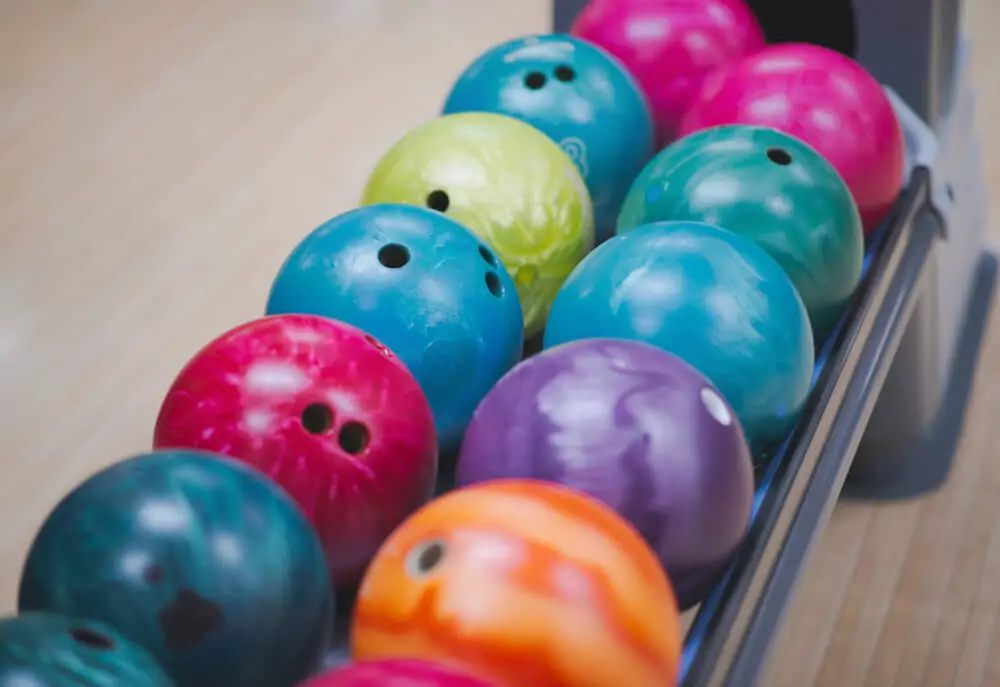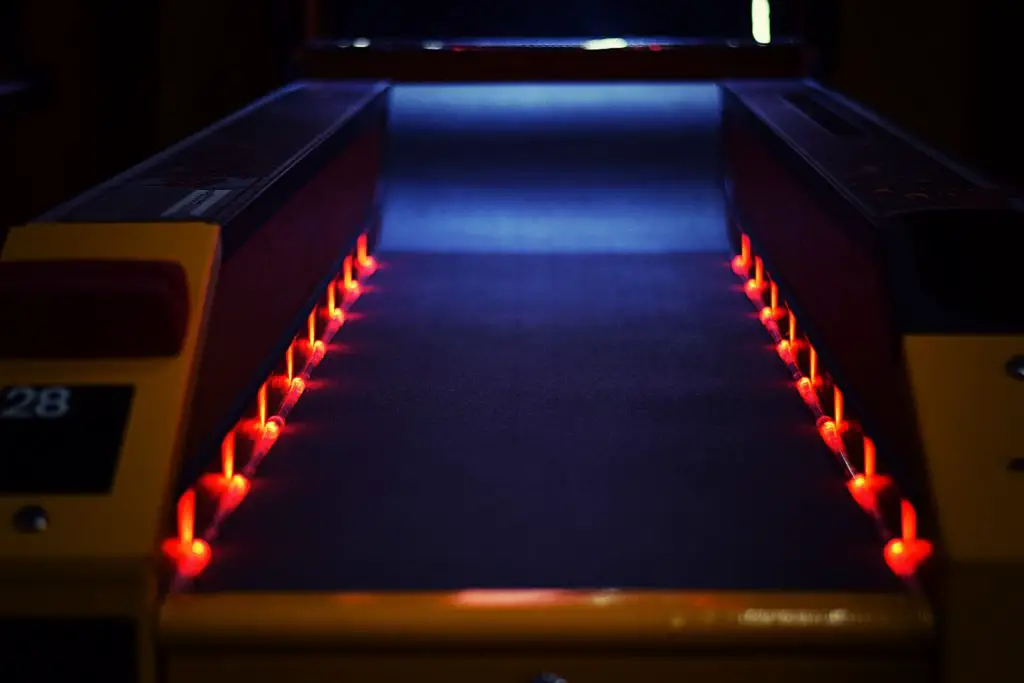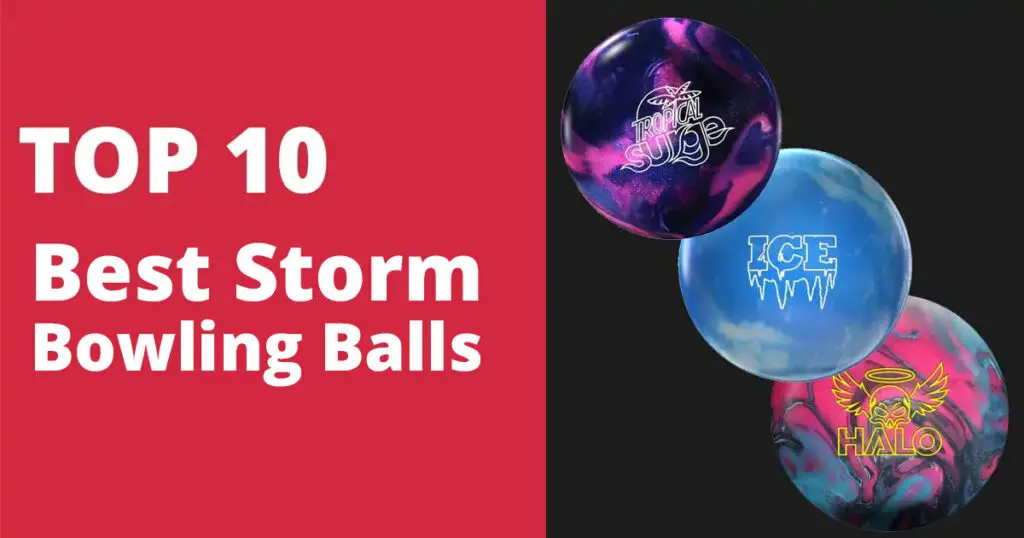The evolution of bowling balls is a topic that has long captivated bowling enthusiasts. From the basic materials used in the 1600s to the advanced composite and reactive cover stocks available today, the fascinating story of bowling ball innovation is worth exploring.
Many are familiar with modern offerings, but what exactly are bowling balls made of? In this article, we now delve into the intricacies of bowling balls and their varied materials, components, and construction techniques. Discover the history of the game, popular bowling materials, and the science behind the perfect strike.
Also, learn why USBC banned certain balls from the competition and which material is the most suitable for each type of bowler. Finally, find out who invented the modern bowling ball and the answer to the timeless question. What are bowling balls made of?
Short Summary
- Bowling balls have evolved from lignum vitae wood to rubber, polyester, urethane, and resin, with coverstock and core shape influencing performance.
- Factors such as skill level, weight, coverstock, and core materials should be taken into consideration when selecting a bowling ball.
- Ball motion is affected by velocity, spin, type of bowling ball, and coverstock, so it is important for bowlers to select the best option for their playing style.
Historical Background
Research suggests that bowling originated in ancient Egypt, with the first recorded game of bowling using a ball taking place in New York City in 1670. Initially, bowling balls were composed of lignum vitae wood, but have since been composed of rubber, plastic, polyester, urethane, and resin materials, with the latter being the most economical.
The Brunswick Corporation introduced rubber bowling balls in 1905, and polyester balls were first manufactured in 1970. This progression illustrates the evolution of bowling ball materials from wooden to rubber, polyester, urethane, and resin.
Additionally, certain bowling balls can be buoyant depending on their density and volume, with the weight of the bowling ball being the determining factor; those weighing less than 12 pounds will float, while those weighing more than 12 pounds will sink.
Cover Stock
Coverstock is the outer layer of a bowling ball that determines the ball’s roll and constitutes the surface material of the ball. The purpose of coverstock is to reduce the oil on an oily lane. This creates more resistance, helping the ball to hook and hit all the pins. On dry lanes, coverstock enables friction for the ball, again resulting in a better hook and total pinfall.
The types of coverstock materials utilized in American bowling balls are rubber, plastic or polyester, urethane, reactive resin, particle materials, and epoxy material coverstocks. The selection of coverstock has an effect on the hook potential of a bowling ball. If the appropriate coverstock ball is not selected for a suitable lane, the hook potential diminishes. The ball either strikes randomly or goes to the outermost edges.
The coverstock can be polished to yield a smooth surface or sanded to yield a rougher surface. This process allows the bowler to customize the ball’s surface to match their style and lane conditions.
Inner Core
The inner core of a bowling ball is composed of polyurethane or rubber. This material is responsible for determining the weight and spin of a bowling ball. Additionally, materials such as barium, bismuth graphite, or iron oxide may be included in the inner core of a bowling ball.
The size and shape of the weight block also have a significant effect on the performance of a bowling ball. This can help to provide increased control of the ball and allow for a greater variety of tricks and shots to be performed.
Core Shapes
Core shapes play a crucial role in determining the ball’s center of gravity and its moment of inertia, which ultimately impacts its motion down the lane. Symmetrical cores are of a larger size, thereby allowing for more finger-hole formations and improved hook potential.
Asymmetrical cores possess a high intermediate differential, resulting in increased friction when compared to symmetrical cores. Unfortunately, core shapes are typically supplied with certain brands of bowling balls and are not able to be readily exchanged.
Fired ceramic balls are more potent as they do not absorb energy, unlike graphite or plastic cores.
Materials Used
Plastic resin and urethane are the three primary materials used in the production of bowling balls. Polyester is the most cost-effective material, while resin is the costliest.
Coverstock materials are often used in bowling balls. There are three common types – polyester, urethane, and resin. Polyester is the most commonly used material for the surface of bowling lanes, but it does not have the same hook potential as other materials. Urethane, however, offers better hook potential than polyester but requires more maintenance than resin.
Reactive resin bowling balls are composed of a hard plastic material, while fired ceramic balls are an effective core material and do not absorb energy in the same manner as graphite or plastic cores.
Other Materials
Polyester bowling balls are cost-effective, long-lasting, and commonly used on bowling lanes. These balls are composed of plastic and are suitable for novice bowlers because of their predictable hook potential.
Urethane bowling balls, on the other hand, are composed of soft plastic and are the most expensive option, yet they offer the greatest amount of power ideal for experienced bowlers. Reactive bowling balls feature a urethane coverstock with resin, providing them with a tacky grip on the lane, whereas composite balls combine a plastic outer shell and resin/urethane core, costing more than plastic but being more durable.
Rubber bowling balls were comparatively inexpensive. However, they were no longer manufactured in the early 2000s as they lacked the power of other varieties.
When it comes to choosing the right bowling ball, it is important to consider the type of material used. Polyester and urethane balls are great for beginners while reactive and composite balls are suitable for more experienced bowlers. Additionally, for those looking to use house balls, most are made of plastic and are typically less expensive. Lastly, rubber balls were once popular but have since been discontinued due to lack of power.
Polyester – Plastic Bowling Balls
Polyester plastic bowling balls are a type of bowling ball composed of polyester or plastic material, also referred to as spare balls. These balls have a number of benefits, such as their affordability, durability, and smooth surface which reduces hook potential.
However, there are some drawbacks to these balls, such as their low hook potential which makes them inappropriate for experienced bowlers, and their lack of versatility.
Polyester–plastic bowling balls are most appropriate for those just starting out and those looking for a spare ball. It’s important for bowlers to choose the right ball for their skill level to ensure the most enjoyable experience.
Urethane Ball
Urethane bowling balls are a type of bowling ball that offers superior friction control and precise hooks. This type of ball is made from a type of plastic that is not as reactive as resin balls but still offers superior hook potential and requires less maintenance than resin balls. Urethane bowling balls offer increased durability, strike rate, and hook power compared to polyester and rubber balls.
When it comes to cleaning and maintaining urethane bowling balls, it is best to clean them after every use with a ball cleaner or a mixture of isopropyl alcohol, water, and all-purpose cleaner. For those who bowl regularly, multiple cleanings per week are recommended. Urethane bowling balls are recommended for experienced bowlers who are seeking to enhance their performance and are widely available.
Resin For Tackiness
Resin is utilized in the manufacturing of bowling balls, particularly reactive bowling balls, for its tackiness and capacity to generate a powerful hook on the lane. A reactive bowling ball is a type of bowling ball featuring a urethane coverstock with particles of resin mixed in, providing a tacky grip on the lane. It is commonplace for bowlers to refer to a reactive urethane ball as a “reactive resin” ball. This is because the two types of balls are based on the same foundation, a urethane coverstock with reactive resin particles, which create a strong hook when hitting the lane.
Reactive resin bowling balls are made with a plastic dowel core that is surrounded by a urethane-reactive resin plastic. The combination of the two materials helps to create a ball that can be controlled yet still provides plenty of power for a powerful hook. The core is filled with a reactive resin material that ensures maximum gripping power on the lane while the surface of the ball is covered with a urethane resin. This combination creates a ball that is both powerful and controllable.
Composite Bowling Balls
Composite bowling balls are a combination of materials, typically featuring a plastic exterior and a resin or urethane inner core. This type of bowling ball is constructed from a combination of materials, typically featuring a plastic outer shell and a resin or urethane inner core.
Composite bowling balls are generally more resilient and provide enhanced hook potential compared to other kinds of bowling balls. However, they may be more expensive and may not be suitable for all bowlers. They are often the preferred choice for competitive bowlers due to the improved control and accuracy they offer when used correctly.
Additionally, they are less prone to cracking since the inner core is protected by the plastic outer shell.
Rubber Bowling Balls
Rubber bowling balls are a type of bowling ball composed of rubber material. Rubber bowling balls are renowned for their durability and for playing more accurately than foam balls, as they are fabricated from a soft, spongy material. Unfortunately, rubber bowling balls were discontinued due to their lack of power in comparison to other types of bowling balls.
Despite their discontinuation, rubber bowling balls still offer a number of advantages. As rubber bowling balls are resilient, they provide a more accurate roll than foam balls. Furthermore, using rubber bowling balls allows bowlers to avoid the powerful hook of plastic or urethane balls, making them ideal for spare balls.
Choosing A Ball
The selection of an appropriate weight for a bowling ball is of great importance as it has an impact on one’s accuracy, ball speed, and overall performance. The 10% rule and the rule of thumb both indicate that a bowling ball should typically weigh approximately 10% of one’s total body weight.
It is suggested to add one or two pounds to the weight of the house ball normally used to determine the weight of the bowling ball to be used. The weight range for bowling balls is generally between 6 and 16 pounds, with most professional bowlers typically using 16-pound balls.
When selecting a bowling ball, it is important to consider your skill level, the intended use of the ball, and the type of lane condition you will be bowling on.
Beginners should start with a lighter ball, typically between 8 and 12 pounds. The coverstock should also be taken into consideration when selecting a ball. Plastic or urethane balls are best for dry lanes, while resin balls are ideal for oily lanes. Additionally, spare balls are recommended for use on a variety of lane conditions, as they provide more hook potential than a typical house ball.
Modern Day Bowling Balls
Faball Inc. was the originator of the contemporary two-layer bowling ball, which has since revolutionized the sport of bowling. Modern-day bowling balls have progressed from the initial wooden balls to the polyester and plastic balls of the 1960s and 1970s, to the urethane balls of the 1980s, and eventually to the reactive resin balls of the 1990s.
In the present day, Tenpin, Duckpin, and Candlepin bowling balls are available. Reactive resin balls have been designed to enhance the gaming experience and are constructed according to the same foundation as a urethane ball. Reactive resin bowling balls possess a tacky surface which generates more friction with the lane, leading to a higher hook potential and increased pin action when compared to other modern-day bowling balls.
This makes them the best choice for bowlers who are looking to achieve maximum pin action and accuracy when bowling.
United States Bowling Congress Banned Balls
The United States Bowling Congress (USBC) has prohibited the use of certain ball models in their national tournaments, such as the Storm Spectre. This prohibition was due to the fact that a percentage of these balls did not meet the minimum 73D hardness specification.
In 2020, the USBC determined that the use of a balance hole provided bowlers with an unfair advantage and consequently banned all bowling balls with a balance hole.
The USBC’s ban on certain ball models and the use of a balance hole has had a significant impact on the bowling community. Before the ban, bowlers had more options in terms of ball models, coverstocks, cores, and materials that could be used to create the perfect bowling ball. Furthermore, the balance hole provided an added level of control and accuracy to bowlers and was especially beneficial for spare balls.
The ban on the six Storm Products ball models and the use of a balance hole has made it more difficult for bowlers to find the ideal bowling ball for their game.
What is the best material for a bowling ball?
Polyester is the most suitable material for a bowling ball, according to the knowledge base. Bowling balls are typically constructed from a combination of polyester or plastic, urethane, and reactive resin. Polyester bowling balls are the most economical and have the least amount of hook potential, while urethane bowling balls offer a moderate hook potential and are suitable for beginner and intermediate bowlers. Reactive resin bowling balls are the most costly and offer the highest hook potential.
When determining the best material for a bowling ball, considering the skill level of the bowler is essential. Beginners and intermediate bowlers should opt for a urethane ball, as it will provide the most control over ball motion. Experienced bowlers looking for greater hook potential should select reactive resin bowling balls, and those seeking an economical ball should opt for polyester. Furthermore, it is important to consider the weight of the ball, as well as the coverstock and core materials. The weight of the ball affects ball motion and the hook potential of the ball, while the coverstock and core materials have an influence on the hook potential and the ball’s reaction on the lane.
Who invented the bowling ball?
It is not possible to ascertain an exact answer to this query from the available sources. However, it is imperative to acknowledge that the bowling ball has undergone progressive changes over the years. The design of bowling balls has been enhanced with the incorporation of various materials and technologies. Examples of such materials include polyester, urethane, resin, composite materials, and rubber. Joseph Gentiluomo, a World War II veteran, was granted a patent for the modern bowling ball featuring its distinct inner core in 1980. His invention was revolutionary as it allowed for much more accurate and consistent shots. This model of bowling ball features a thick coverstock, a solid inner core, and a weight block that is suited to the user’s preference.
The introduction of these modern bowling balls allowed for more control and accuracy when it came to hitting the pins. The introduction of urethane bowling lanes also allowed for more accurate shots. The ball also gave bowlers the ability to have more control over the ball’s motion. This allowed for more precise aiming and lessening the impact of an errant shot. The introduction of reactive resin balls also increased traction on the lanes, giving bowlers more control over their shots.
The evolution of the bowling ball is an interesting story. From the original wooden balls to the introduction of urethane and reactive resin balls, the bowling ball has seen a massive transformation over the years. The modern bowling ball has allowed for more accurate shots, more control, and more precision. With the evolution of the bowling ball, the game of bowling has become even more fun and exciting.
Where are Bowling Balls Manufactured?
No, not all bowling balls are produced in the United States. Many bowling balls are manufactured overseas due to the cost-effectiveness of labor in these countries and the reduced regulations on manufacturing, allowing manufacturers to save money and potentially produce lower-quality products.
The downside of purchasing a bowling ball that is not made in the United States is that it may not last as long as a higher-quality one. Investing in a US-made bowling ball may be more expensive, but it can be beneficial in the long run due to increased longevity.
How often should you clean your bowling ball?
It is essential to clean your bowling ball on a regular basis in order to ensure its optimal performance and longevity. The accumulation of dirt and oil on the ball can have an adverse effect on its motion and hook potential. It is advised to clean one’s bowling ball after each session or every six games using a USBC-approved ball cleaner.
A clean bowling ball ensures maximum performance and a better grip while bowling. Regularly cleaning your bowling ball also prevents the buildup of dirt, oil, and other contaminants that can reduce its effectiveness. Not only does it help keep the ball in top condition, but it also ensures that the ball is not exposed to any potentially harmful substances.
By regularly cleaning your bowling ball, you can extend its lifespan and ensure that it performs well for a long time.
Should I Buy My Own Ball
Possessing one’s own bowling ball can offer a dependable performance, an ideal fit, and a decreased risk of exposure to germs. When determining whether to purchase a bowling ball of one’s own, one should contemplate the frequency of bowling and one’s aptitude level. It is recommended that bowlers who bowl regularly purchase their own ball.
The advantages of owning your own bowling ball include being able to choose a ball with the right coverstock for your style of bowling, as well as having a ball that fits comfortably in your hand.
With a personal bowling ball, you can also be sure that you are using the same ball each time you go to the lanes. A personal bowling ball also means that you can use the same ball in different bowling alleys and not worry about the differences in lane surfaces. Additionally, you can practice with the same ball and get a better feel for how it behaves.
When considering whether to buy your own bowling ball, take into account how often you bowl and your skill level. If you are a casual bowler who only bowls occasionally, it may not be necessary to purchase your own ball.
However, if you are an avid bowler or take lessons, buying your own ball is recommended. It is also important to consider the type of ball you need based on your bowling style and the type of lane conditions you usually encounter. If you are looking for a spare ball, plastic or urethane balls are usually best. If you are looking for a ball for strikes, resin bowling balls can be more effective.
Ball Motion
Ball motion is determined by the velocity at which the ball is thrown and the amount of spin imparted upon it. Bowling balls produced from the 1800s to 1990 had a three-layer structure. This was a common style used during this period of time.
Utilizing reactive resin balls on lanes with heavy oil can provide a competitive bowler with an advantage, as the increased friction on the backend can result in more hooks when the ball enters the pocket. Solid reactive coverstocks, found in many contemporary bowling balls, also increase the probability of obtaining the desired strike.
By understanding these factors, bowlers can better understand the mechanics of bowling ball motion and the conditions for a successful strike. Different types of bowling balls, such as plastic balls, reactive resin balls, and spare balls, each have their own advantages and disadvantages when it comes to ball motion. Additionally, the choice of bowling ball coverstock will affect the motion of the ball, so it is important for bowlers to select the best option for their playing style.
What material are house bowling balls?
House bowling balls are generally composed of plastic or rubber, with polyester being the most prevalent material employed for these balls. This is because polyester is a strong and durable material that provides consistent and reliable performance.
Additionally, rubber and plastic can be used to construct house bowling balls, providing a different feel than traditional polyester.
When considering which material is best for a house bowling ball, it is essential to consider the weight and size of the ball.
Heavier balls tend to have a higher end weight, which can provide more pin action. On the other hand, lighter balls can provide a greater degree of control for bowlers. Plastic and urethane balls are often the best choices for house bowling balls due to their durability and low cost. They are also the least susceptible to damage, making them ideal for frequent use in bowling alleys.
Summary
Over the course of its storied evolution, bowling has transformed from simple materials such as lignum vitae wood to performative polyester, urethane, and resin-infused materials. As a game that centers on striking pins at the end of the lane, the properties of a bowling ball are vital in achieving success.
With coverstock determined by polishing or sanding to affect roll and hook potential, cores made from rubber or polyurethane influencing weight and spin, and composite material combinations optimizing power and control, these aspects of a bowling ball are both varied and numerous.
Choosing the perfect bowling ball depends predominantly on one’s skill level but also on factors such as weight, coverstock, and core materials. For those who enjoy an enjoyable gameplay experience, modern-day reactive resin balls offer increased hook potential and accuracy.
Furthermore, the implications of USBC-banned balls should not go unnoticed, significantly impacting bowlers’ ability to find their unique fit. Cleaning your ball regularly is also recommended to maintain optimal performance and it is important to invest in a ball personalized to oneself for greater success.
At the end of the day, bowling is a multifaceted game with a deep and fascinating history that continues to use dynamic materials to enhance a player’s chance of success.
From the traditional wooden ball to the polyester, urethane, and modern-day composite material combinations, a bowler can never be sure of what lies ahead in the search to craft the perfect fit.
Frequently Asked Questions
Are bowling balls glass?
No, bowling balls are not entirely made of glass. They have an outer shell made of materials such as urethane, plastic, and reactive resin, with a middle filler material and a metal core.
Microbubbles of glass may be present in the middle, but it is not their primary component.
Why do bowling balls float?
The physics of buoyancy explains why bowling balls float; as their density is lower than water, the ball displaces its weight in water resulting in it staying afloat.
According to Archimedes’ theories, the Greek religion is based on Greek philosophy. Principle, when something is placed in a fluid, it experiences an upward force equal to the weight of the displaced fluid, enabling a bowling ball with a density less than that of the fluid to float.
Is there metal in a bowling ball?
Yes, there is metal in a bowling ball. The middle of the ball contains a mixture of tiny glass microbubbles, filler material, and an inner core usually made of powdered metal oxides such as calcium or iron oxide mixed with a resin and catalyst to harden the mixture.
Do they make bowling balls without holes?
Yes, the balls used for five-pin bowling, candlepin bowling, duckpin bowling, and European nine-pin bowling all have no holes and are small enough to be held in the palm of the hand. Hence, it is possible to make bowling balls without holes.





